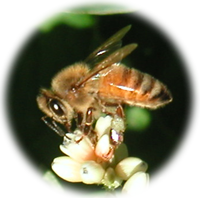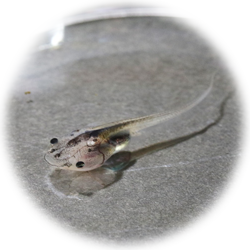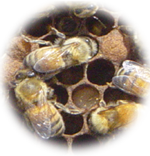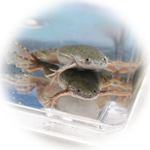Research

|
Study of the molecular basis underlying honeybee social behavior
|
The honeybee (Apis mellifera L. ) is a social insect and the female adults differentiate into two castes: queens and workers. The workers change their roles from nursing the brood, guarding the colony from natural enemies to foraging for nectar and pollen, depending on their age after eclosion (age-polyethism). Furthermore, the workers inform the other foragers of the direction and distance of a food source using dance language. The molecular basis of such highly advanced behaviors of the honeybees, however, remains unclear. The mushroom bodies (MBs) are thought to be important regions for sensory integration, learning, and memory in the insect brain and are well-developed in the honeybee brain. In our laboratory, aiming at identifying candidate genes involved in the highly advanced honeybee behaviors, we have been performing systematic identification of genes expressed in the honeybee brains in MB-preferential and/or behavior-dependent manners using a combination of the differential display method and cDNA microarray analysis. To date, we have reported that the expression of the genes for proteins involved in the Ca2+-signaling pathway is upregulated in the MBs in the honeybee brain. We also identified a novel transcription factor, termed Mblk-1, which is expressed selectively in one of the two neural subtypes that comprise the honeybee MBs: a novel non-coding nuclear RNA, termed Ks-1, and a tachykinin-related neurosecretory peptide and a novel non-coding nuclear RNA, termed AncR-1whose expression in the brain differs in association with honeybee behavior. Recently, we identified a novel picorna-like virus, termed kakugo, which is detected selectively in the brains of the aggressive worker bees. Furthermore, we have developed a method to transfer genes into adult honeybee brains by electroporation to facilitate functional analysis of the genes involved in honeybee behaviors. Study on the genes involved in honeybee behavior will contribute to a better understanding of the molecular basis of animal behaviors in general as well as the evolution of insect sociality. A part of this research has been performed in collaboration with the Graduate School of Medicine, University of Tokyo; Faculty of Agriculture, Tamagawa University; Suntory Bioorganic Research Institute; and DNA Chip Research Inc.

|
Analysis of the molecular mechanisms of the animal (amphibian) organ regeneration
|
Although regenerative ability is scarce in mammalian organs, some animals possess high ability to regenerate their lost organs. In our laboratory, we identified genes and proteins involved in leg regeneration using the American cockroach (Periplaneta americana). In particular, we have reported that some members of the humoral lectin family (a class of insect defense proteins), termed the Periplaneta lectin family, appear transiently in the regenerating cockroach legs, suggesting common molecular aspects between innate immunity and organ regeneration in insects. We are now working to identify genes involved in tail regeneration in the Xenopus laevis tadpole and their functional analysis using two approaches: The first is the identification of the Xenopus counterparts of the cockroach proteins involved in leg regeneration; the second is the systematic screening of the genes expressed preferentially in the regenerating Xenopus tadpole tails. One of the advantages of using Xenopus laevis as an experimental animal for the study of organ regeneration is that reverse-genetic methods can be applied in this animal. Our goal is to stimulate the regenerative ability in mammals by activating expression of the counterparts of the genes identified as those involved in organ regeneration in Xenopus laevis.
(UTokyo Research) Gene shown to induce undifferentiated cells during tadpole tail regeneration - Earliest stage of regeneration reproduced in lab
|
|

 Japanese /
Japanese /  English
English




